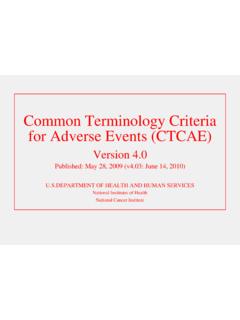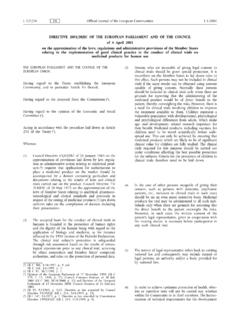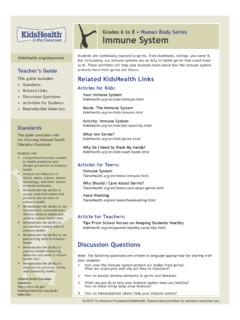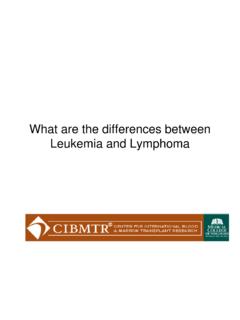Transcription of Common Terminology Criteria for Adverse Events …
1 1. CTCAE Common Terminology Criteriafor Adverse Events (CTCAE)Version : May 28, 2009 ( : June 14, 2010) OF HEALTH AND HUMAN SERVICESN ational Institutes of HealthNational Cancer Institute_____ CTCAE incorporates certain elements of the MedDRA Terminology . For further details on MedDRA refer to the MedDRA MSSO Web site ( ). Common Terminology Criteria for Adverse Events (CTCAE) Publish Date: May 28, 2009 Quick Reference The NCI Common Terminology Criteria for Adverse Events is a descriptive Terminology which can be utilized for Adverse Event (AE) reporting. A grading (severity) scale is provided for each AE term. Components and Organization SOC system Organ Class, the highest level of the MedDRA hierarchy, is identified by anatomical or physiological system , etiology, or purpose ( , SOC Investigations for laboratory test results). CTCAE terms are grouped by MedDRA Primary SOCs. Within each SOC, AEs are listed and accompanied by descriptions of severity (Grade).
2 CTCAE Terms An Adverse Event (AE) is any unfavorable and unintended sign (including an abnormal laboratory finding), symptom, or disease temporally associated with the use of a medical treatment or procedure that may or may not be considered related to the medical treatment or procedure. An AE is a term that is a unique representation of a specific event used for medical documentation and scientific analyses. Each CTCAE term is a MedDRA LLT (Lowest Level Term). Definitions A brief definition is provided to clarify the meaning of each AE term. Grades Grade refers to the severity of the AE. The CTCAE displays Grades 1 through 5 with unique clinical descriptions of severity for each AE based on this general guideline: Grade 1 Mild; asymptomatic or mild symptoms; clinical or diagnostic observations only; intervention not indicated. Grade 2 Moderate; minimal, local or noninvasive intervention indicated; limiting age-appropriate instrumental ADL*.
3 Grade 3 Severe or medically significant but not immediately life-threatening; hospitalization or prolongation of hospitalization indicated; disabling; limiting self care ADL**. Grade 4 Life-threatening consequences; urgent intervention indicated. Grade 5 Death related to AE. A Semi-colon indicates or within the description of the grade. A single dash (-) indicates a grade is not available. Not all Grades are appropriate for all AEs. Therefore, some AEs are listed with fewer than five options for Grade selection. Grade 5 Grade 5 (Death) is not appropriate for some AEs and therefore is not an option. Activities of Daily Living (ADL) *Instrumental ADL refer to preparing meals, shopping for groceries or clothes, using the telephone, managing money, etc. **Self care ADL refer to bathing, dressing and undressing, feeding self, using the toilet, taking medications, and not bedridden. SOCPageBlood and lymphatic system disorders3 Cardiac disorders6 Congenital, familial and genetic disorders15 Ear and labyrinth disorders16 Endocrine disorders19 Eye disorders22 Gastrointestinal disorders28 General disorders and administration site conditions55 Hepatobiliary disorders61 Immune system disorders65 Infections and infestations68 Injury, poisoning and procedural complications87 Investigations107 Metabolism and nutrition disorders114 Musculoskeletal and connective tissue disorders119 Neoplasms benign, malignant and unspecified (incl cysts and polyps)128 Nervous system disorders129 Pregnancy, puerperium and perinatal conditions141 Psychiatric disorders142 Renal and urinary disorders147 Reproductive system and breast disorders153 Respiratory, thoracic and mediastinal disorders164 Skin and subcutaneous tissue disorders179 Social circumstances188 Surgical and medical procedures189 Vascular disorders190 CTCAE - June 14, 2010 32.
4 Blood and lymphatic system disordersBlood and lymphatic system disordersGradeAdverse Event12345 AnemiaHemoglobin (Hgb) <LLN g/dL; <LLN - mmol/L;<LLN - 100 g/LHgb < - g/dL; < mmol/L; <100 - 80g/LHgb < g/dL; < mmol/L;<80 g/L; transfusion indicatedLife-threateningconsequences; urgentintervention indicatedDeathDefinition: A disorder characterized by an reduction in the amount of hemoglobin in 100 ml of blood. Signs and symptoms of anemia may include pallor of the skin andmucous membranes, shortness of breath, palpitations of the heart, soft systolic murmurs, lethargy, and marrow hypocellularMildly hypocellular or <=25%reduction from normalcellularity for ageModerately hypocellular or>25 - <50% reduction fromnormal cellularity for ageSeverely hypocellular or >50 -<=75% reduction cellularityfrom normal for ageAplastic persistent for longerthan 2 weeksDeathDefinition: A disorder characterized by the inability of the bone marrow to produce hematopoietic intravascularcoagulation -Laboratory findings with nobleedingLaboratory findings andbleedingLife-threateningconsequences; urgentintervention indicatedDeathDefinition: A disorder characterized by systemic pathological activation of blood clotting mechanisms which results in clot formation throughout the body.
5 There is anincrease in the risk of hemorrhage as the body is depleted of platelets and coagulation neutropenia - -ANC <1000/mm3 with a singletemperature of > degreesC (101 degrees F) or asustained temperature of>=38 degrees C ( F) for more than ; urgentintervention indicatedDeathDefinition: A disorder characterized by an ANC <1000/mm3 and a single temperature of > degrees C (101 degrees F) or a sustained temperature of >=38 degrees C( degrees F) for more than one - June 14, 2010 : Blood and lymphatic system disorders 4 Blood and lymphatic system disordersGradeAdverse Event12345 HemolysisLaboratory evidence ofhemolysis only ( , directantiglobulin test; DAT;Coombs'; schistocytes;decreased haptoglobin)Evidence of hemolysis and>=2 gm decrease or medicalintervention indicated ( ,steroids)Life-threateningconsequences; urgentintervention indicatedDeathDefinition: A disorder characterized by laboratory test results that indicate widespread erythrocyte cell membrane uremic syndromeEvidence of RBC destruction(schistocytosis) withoutclinical consequences -Laboratory findings withclinical consequences ( ,renal insufficiency, petechiae)Life-threateningconsequences, ( , CNShemorrhage orthrombosis/embolism or renalfailure)DeathDefinition: A disorder characterized by a form of thrombotic microangiopathy with renal failure, hemolytic anemia, and severe - ->100,000/mm3 Clinical manifestations ofleucostasis; urgentintervention indicatedDeathDefinition: A disorder characterized by laboratory test results that indicate an increased number of white blood cells in the node painMild painModerate pain; limitinginstrumental ADLS evere pain.
6 Limiting self careADL - -Definition: A disorder characterized by a sensation of marked discomfort in a lymph disorderIncidental findings ( ,Howell-Jolly bodies); milddegree of thrombocytosis andleukocytosisProphylactic antibioticsindicated -Life-threateningconsequences; urgentintervention indicatedDeathCTCAE - June 14, 2010 : Blood and lymphatic system disorders 5 Blood and lymphatic system disordersGradeAdverse Event12345 Definition: A disorder of the thrombocytopenicpurpuraEvidence of RBC destruction(schistocytosis) withoutclinical consequences -Laboratory findings withclinical consequences ( ,renal insufficiency, petechiae)Life-threateningconsequences, ( , CNShemorrhage orthrombosis/embolism or renalfailure)DeathDefinition: A disorder characterized by the presence of microangiopathic hemolytic anemia, thrombocytopenic purpura, fever, renal abnormalities and neurologicalabnormalities such as seizures, hemiplegia, and visual disturbances. It is an acute or subacute and lymphatic systemdisorders - Other, specifyAsymptomatic or mildsymptoms; clinical ordiagnostic observations only;intervention not indicatedModerate; minimal, local ornoninvasive interventionindicated; limiting age-appropriate instrumental ADLS evere or medically significantbut not immediately life-threatening; hospitalization orprolongation of existinghospitalization indicated;disabling; limiting self careADLLife-threateningconsequences; urgentintervention indicatedDeathCTCAE - June 14, 2010 : Cardiac disorders 63.
7 Cardiac disordersCardiac disordersGradeAdverse Event12345 Acute coronary syndrome -Symptomatic, progressiveangina; cardiac enzymesnormal; hemodynamicallystableSymptomatic, unstable anginaand/or acute myocardialinfarction, cardiac enzymesabnormal, hemodynamicallystableSymptomatic, unstable anginaand/or acute myocardialinfarction, cardiac enzymesabnormal, hemodynamicallyunstableDeathDefinition: A disorder characterized by signs and symptoms related to acute ischemia of the myocardium secondary to coronary artery disease. The clinical presentationcovers a spectrum of heart diseases from unstable angina to myocardial valve diseaseAsymptomatic valvularthickening with or without mildvalvular regurgitation orstenosis by imagingAsymptomatic; moderateregurgitation or stenosis byimagingSymptomatic; severeregurgitation or stenosis byimaging; symptoms controlledwith medical interventionLife-threateningconsequences ; urgentintervention indicated ( ,valve replacement,valvuloplasty)DeathDefinitio n: A disorder characterized by a defect in aortic valve function or of asystole; non-urgent medical managementindicated - -Life-threateningconsequences; urgentintervention indicatedDeathDefinition: A disorder characterized by a dysrhythmia without cardiac electrical activity.
8 Typically, this is accompanied by cessation of the pumping function of the fibrillationAsymptomatic, interventionnot indicatedNon-urgent medicalintervention indicatedSymptomatic andincompletely controlledmedically, or controlled withdevice ( , pacemaker), orablationLife-threateningconsequences; urgentintervention indicatedDeathCTCAE - June 14, 2010 : Cardiac disorders 7 Cardiac disordersGradeAdverse Event12345 Definition: A disorder characterized by a dysrhythmia without discernible P waves and an irregular ventricular response due to multiple reentry circuits. The rhythmdisturbance originates above the flutterAsymptomatic, interventionnot indicatedNon-urgent medicalintervention indicatedSymptomatic andincompletely controlledmedically, or controlled withdevice ( , pacemaker), orablationLife-threateningconsequences; urgentintervention indicatedDeathDefinition: A disorder characterized by a dysrhythmia with organized rhythmic atrial contractions with a rate of 200-300 beats per minute.
9 The rhythm disturbance originatesin the blockcomplete -Non-urgent interventionindicatedSymptomatic andincompletely controlledmedically, or controlled withdevice ( , pacemaker)Life-threateningconsequences; urgentintervention indicatedDeathDefinition: A disorder characterized by a dysrhythmia with complete failure of atrial electrical impulse conduction through the AV node to the block firstdegreeAsymptomatic, interventionnot indicatedNon-urgent interventionindicated - - -Definition: A disorder characterized by a dysrhythmia with a delay in the time required for the conduction of an electrical impulse through the atrioventricular (AV) nodebeyond seconds; prolongation of the PR interval greater than 200 arrest - - -Life-threateningconsequences; urgentintervention indicatedDeathDefinition: A disorder characterized by cessation of the pumping function of the - June 14, 2010 : Cardiac disorders 8 Cardiac disordersGradeAdverse Event12345 Chest pain - cardiacMild painModerate pain; limitinginstrumental ADLPain at rest; limiting self careADL - -Definition: A disorder characterized by substernal discomfort due to insufficient myocardial disorderMild symptoms; interventionnot indicatedModerate symptomsSevere symptoms;intervention indicatedLife-threateningconsequences; urgentintervention indicatedDeathDefinition: A disorder characterized by pathological irregularities in the cardiac conduction pericarditis - -Symptomatic heart failure orother cardiac symptoms,responsive to interventionRefractory heart failure orother poorly controlled cardiacsymptomsDeathDefinition: A disorder characterized by a thickened and fibrotic pericardial sac.
10 These fibrotic changes impede normal myocardial function by restricting myocardial failureAsymptomatic with laboratory( , BNP [B-NatriureticPeptide ]) or cardiac imagingabnormalitiesSymptoms with mild tomoderate activity or exertionSevere with symptoms at restor with minimal activity orexertion; interventionindicatedLife-threateningcon sequences; urgentintervention indicated ( ,continuous IV therapy ormechanical hemodynamicsupport)DeathDefinition: A disorder characterized by the inability of the heart to pump blood at an adequate volume to meet tissue metabolic requirements, or, the ability to do so only at anelevation in the filling - June 14, 2010 : Cardiac disorders 9 Cardiac disordersGradeAdverse Event12345 Left ventricular systolicdysfunction - -Symptomatic due to drop inejection fraction responsive tointerventionRefractory or poorly controlledheart failure due to drop inejection fraction; interventionsuch as ventricular assistdevice, intravenousvasopressor support, or hearttransplant indicatedDeathDefinition: A disorder characterized by failure of the left ventricle to produce adequate output despite an increase in distending pressure and in end-diastolic volume.










